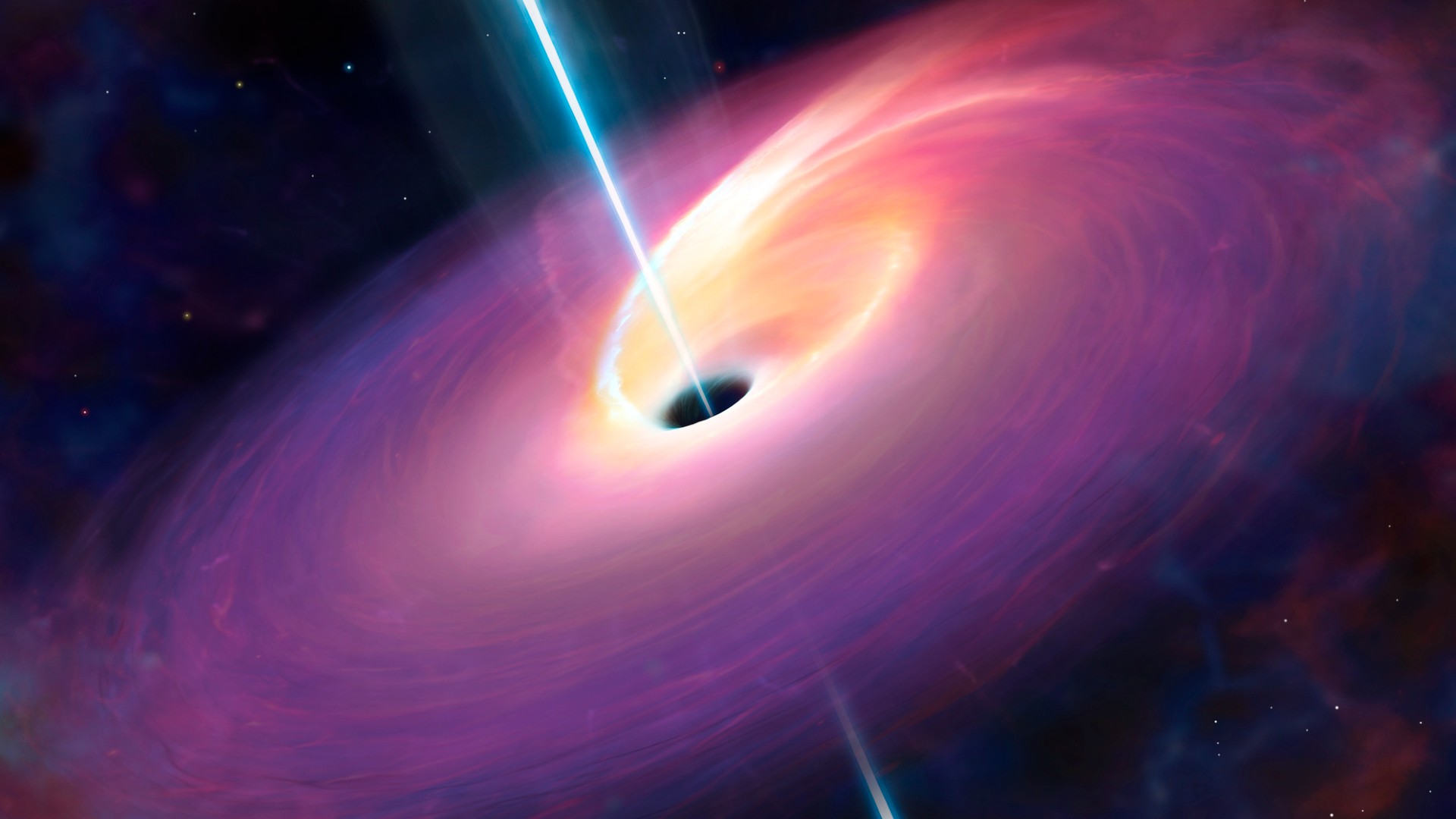Hungry black hole shoots out bright X-ray jet 60,000 times hotter than the sun
The quasar is 100,000 billion times brighter than the sun.

Astronomers stared deep into the heart of a hungry black hole, only to discover a jet of X-rays beaming out of it that is 60,000 times hotter than the surface of the sun.
In simple terms, quasars are black holes with bright, energetic jets of electromagnetic radiation beaming out of them from two sides as they feed on gases at the center of galaxies. The quasar imaged by the team in X-rays is known as SMSS J114447.77–430859.3 (J1144) and is the most luminous example of such an object seen in the last 9 billion years of cosmic history. Located at the heart of a galaxy around 9.6 billion light -years away from Earth and seen in the sky between the constellations of Centaurus and Hydra, this quasar is around 100,000 billion times brighter than the sun.
Quasars like J1144 are so bright they often outshine the combined light of every star in the galaxies that house them. They are examples of so-called active galactic nuclei (AGN) that are found only at vast distances from Earth and, thus, in the early universe. Studying the quasar could offer astronomers a detailed insight into these powerful cosmic events and the effect they have on their galactic surroundings.
Related: Quasars: Brightest Objects in the Universe
Scientists theorize that the reason quasars are found in the early universe is that galaxies just a short time after the Big Bang were richer in gas and dust. This meant they possessed enough fuel to allow their central black holes to power bright emissions across almost the entire electromagnetic spectrum, including low-energy radio, infrared, visible, ultraviolet wavelengths, and high-energy X-ray wavelengths.
J1144 was initially spotted in visible light by SkyMapper Southern Survey (SMSS) in 2022. To follow up on this discovery, the team, also led by Max Planck Institute for Extraterrestrial Physics (MPE) Ph.D. candidate Zsofi Igo, combined observations from several space-based observatories. These included the Spectrum-Roentgen-Gamma (SRG) observatory's eROSITA instrument, the ESA XMM-Newton observatory, NASA's Nuclear Spectroscopic Telescope Array (NuSTAR), and NASA's Neil Gehrels Swift observatory.
This combination of data allowed the astronomers to measure the temperature of the X-rays coming from the quasars, discovering them to be around 630 million degrees Fahrenheit (350 million degrees Celsius). This is a staggering 60,000 times hotter than the temperature at the surface of the sun.
Get the Space.com Newsletter
Breaking space news, the latest updates on rocket launches, skywatching events and more!
The team was also able to put a value on the mass of the black hole behind these emissions, finding it to be around 10 billion times that of the sun. Not only this, but the supermassive black hole of J1144 is feeding so quickly that it is growing at a rate of 100 suns per year. Not all the gas surrounding this black hole is being fed to it, however.
The scientists discovered that some gas is being ejected from the quasar in the form of extremely powerful winds that are injecting vast amounts of energy into its surrounding galaxy.
The team also found that J1144 has a characteristic that sets it apart from other quasars: The X-ray light it emits varies on a timescale of just a few Earth days. For a quasar with a black hole this size, the variability of its X-rays would usually be on a timescale of months or even years.
"We were very surprised that no prior X-ray observatory has ever observed this source despite its extreme power," Kammoun added. "A new monitoring campaign of this source will start in June this year, which may reveal more surprises from this unique source."
The team's research is published in the journal Monthly Notices of the Royal Astronomical Society.
Join our Space Forums to keep talking space on the latest missions, night sky and more! And if you have a news tip, correction or comment, let us know at: community@space.com.

Robert Lea is a science journalist in the U.K. whose articles have been published in Physics World, New Scientist, Astronomy Magazine, All About Space, Newsweek and ZME Science. He also writes about science communication for Elsevier and the European Journal of Physics. Rob holds a bachelor of science degree in physics and astronomy from the U.K.’s Open University. Follow him on Twitter @sciencef1rst.
-
bibhutibhusanpatel@gmail. The ŕapid variability in the x-ray emission from the brightest quasr is due to following two reasons -Reply
1 . The quasar is present nearer to big bang,that is,4.6 billion years after the big bang.
2 . As the quasar has a huge supermassive black hole,is bounded by a large number of small nonsatellite galaxies.So,the effective value of rotation results such rapidly variable x-ray emission from the binary jets emerging in opposite directions.









